Correlation between Heavy Metal-Induced Histopathological Changes and Trophic Interactions between Different Fish Species
Abstract
1. Introduction
2. Materials and Methods
2.1. Sampling
2.2. Heavy Metals Concentration in Water and Sediments
2.3. Bioaccumulation of Heavy Metal in the Gills, Liver, and Kidney
2.4. Histopathology
2.5. Immunohistochemistry
2.6. Protein Extraction and Western Blot Analysis
2.7. Statistical Analysis
3. Results and Discussion
3.1. Heavy Metal Concentrations in Water and Reservoir Sediments
3.2. Metal Bioaccumulation in the Gills, Liver, and Kidneys
3.3. Histopathology
3.4. Heavy Metal Bioaccumulation Activates Inflammatory Pathways in the Gills, Liver, and Kidney of BB, CN, and SC
3.5. Heavy Metal Bioaccumulation Activates Reparatory Mechanisms in Gills, Liver, and Kidney of Barbus barbus, Chondrostoma nasus, and Squalius cephalus
4. Conclusions
Author Contributions
Funding
Institutional Review Board Statement
Data Availability Statement
Conflicts of Interest
References
- Sánchez-Bayo, F. Sources and Toxicity of Pollutants. In Ecological Impacts of Toxic Chemicals; Sánchez-Bayo, F., van den Blink, P., Mann, R.M., Eds.; Bentham Science Publisher Ltd.: Potomac, MD, USA, 2011; pp. 3–12. [Google Scholar]
- Nriagu, J.O. A global assessment of natural sources of atmospheric trace metals. Nature 1989, 338, 47–49. [Google Scholar] [CrossRef]
- Briffa, J.; Sinagra, E.; Blundell, R. Heavy metal pollution in the environment and their toxicological effects on humans. Helyon 2020, 6, e04691. [Google Scholar] [CrossRef] [PubMed]
- Schäfer, S.; Buchmeier, G.; Claus, E.; Duester, L.; Heininger, P.; Körner, A.; Mayer, P.; Paschke, A.; Rauert, C.; Reifferscheid, G.; et al. Bioaccumulation in aquatic systems: Methodological approaches, monitoring and assessment. Environ. Sci. Eur. 2015, 27, 5. [Google Scholar] [CrossRef] [PubMed]
- Jezieerska, B.; Witeska, M. Uptake and accumulation in fish living in polluted waters. In Soil and Water Pollution Monitoring, Protection and Remediation; Twardowska, I., Allen, H.E., Häggblon, M.M., Eds.; NATO Science Series IV Earth and Environmental Sciences; Springer: Berlin/Heidelberg, Germany, 2006; Volume 69, pp. 107–114. [Google Scholar]
- Novikova, L.V.; Gaisin, A.R.; Stepanova, N.Y. The Content of Metals in Tissues and Organs of Fish of Different Trophic Levels in the Estuary of the Kama River. In IOP Conference Series: Earth and Environmental Science; IOP Publishing: Bristol, UK, 2019; Volume 272, p. 022211. [Google Scholar]
- Weber, P.; Behr, E.R.; Knorr, C.D.L.; Vendruscolo, D.S.; Flores, E.M.M.; Dressler, V.L.; Baldisserotto, B. Metals in the water, sediment and tissues of two fish species from different trophic levels in a subtropical Brazilian river. Microchem. J. 2013, 106, 61–66. [Google Scholar] [CrossRef]
- Shinn, C.A.; Dauba, F.; Grenouillet, G.; Guenard, G.; Lek, S. Temporal variation of heavy metal contamination in fish of the river lot in southern France. Ecotoxicol. Environ. Saf. 2009, 72, 1957–1965. [Google Scholar] [CrossRef] [PubMed]
- Prashanth, L.; Kattapagari, K.K.; Chitturi, R.T.; Baddam, V.R.; Prasad, L.K. A review on role of essential trace elements in health and disease. JNTR Univ. Health Sci. 2015, 4, 75–85. [Google Scholar]
- Mieiro, C.L.; Duarde, A.C.; Pereira, M.E.; Pacheco, M. Mercury accumulation patterns and biomedical endpoints in wild fish (Liza aurata): A multiorgan approach. Ecotox. Environ. Safety 2011, 74, 2225–2232. [Google Scholar] [CrossRef] [PubMed]
- Mahboob, S.; Kausar, S.; Jabeen, F.; Sultana, S.; Sultana, T.; Al-Ghanim, K.A.; Hussain, B.; Al-Misned, F.; Ahmed, Z. Effect of heavy metals in liver, kidney, gills and muscles of Cyprinus carpio and Wallago attu inhabited in the Indus. Braz. Arch. Biol. Technol. 2016, 59, 1–10. [Google Scholar] [CrossRef]
- Lushchak, V.I. Contaminant induced oxidative stress in fish: A mechanistic approach. Fish Physiol. Biochem. 2016, 42, 711–747. [Google Scholar] [CrossRef] [PubMed]
- Sabullah, M.K.; Ahmad, S.; Shukor, M.Y.; Gansau, A.J.; Syed, M.A.; Sulaiman, M.R.; Shamaan, N.A. Heavy metal biomarkers: Fish behavior, cellular alteration, enzymatic reaction and proteonic approaches. Int. Food Res. J. 2015, 22, 435–454. [Google Scholar]
- Hermenean, A.; Damache, G.; Albu, P.; Ardelean, A.; Ardelean, G.; Ardelean, D.P.; Horge, M.; Nagy, T.; Braun, M.; Zsuga, M.; et al. Histopathological alterations and oxidative stress in liver and kidney of Leuciscus cephalus following exposure to heavy metals in the Tur River, North Western Romania. Ecotoxicol Environ. Saf. 2015, 119, 198–205. [Google Scholar] [CrossRef] [PubMed]
- Li, S.; Tan, H.-Y.; Wang, N.; Feng, Y. Insights into the role and interpendence of oxidtive and inflammation in liver diseaes. Oxid. Med. Cell Longev. 2016, 2016. [Google Scholar] [CrossRef] [PubMed]
- Sun, Y.; Li, Y.; An, J.; Liu, Z.; Chen, Q. Antioxidative and inflammatory responses in spleen and head kidney of Yellow Catfish (Pelteobagrus fulvidraco) induced by waterborne cadmium exposure. Turk. J. Fish. Aquat. Sci. 2019, 20, 8796. [Google Scholar]
- Petrovici, M.; Paciogl, O. Heavy metal concentrations in two species of fish from the Crișul Negru River, Romania. AACL Bioflux. 2010, 3, 51–60. [Google Scholar]
- Banarescu, P.; Murgoci, A. Pisces-Osteichthyes: (Peşti Ganoizi şi Osoşi); Editura Academiei Romane: Bucureti, Romania, 1964. [Google Scholar]
- Gergely, I.; Oprea, J.E.; Sion, L.; Călin, P.G. The influence of structural changes and ichtyofauna abundance on the ecological state of the Crisuri hydrographic area. AACL Bioflux 2011, 4, 170–179. [Google Scholar]
- Abdel-Moneim, M.; Al-Kahtani, M.A.; Elmenshawy, O.M. Histopathological biomarkers in gills and liver of Oreochromis niloticus from polluted wetland environments, Saudi Arabia. Chemosphere 2012, 88, 1028–1035. [Google Scholar] [CrossRef]
- Triebskorn, R.; Telcean, I.; Casper, H.; Farkas, A.; Sandu, C.; Stan, G.; Colarescu, O.; Dori, T.; Kohler, H.R. Monitoring pollution in River Mures, Romania, part II: Metal accumulation and histopathology in fish. Environ. Monit. Assess. 2008, 4, 177–188. [Google Scholar] [CrossRef]
- Mishra, A.K.; Mohanty, B. Acute toxicity impacts of hexavalent chromium on behavior and histopathology of gill, kidney and liver of the freshwater fish, Channa punctatus (Bloch). Environ. Toxicol. Pharmacol. 2008, 26, 136–141. [Google Scholar] [CrossRef]
- Tchounwou, P.B.; Yedjou, C.G.; Patlolla, A.K.; Sutton, D.J. Heavy Metal Toxicity and the Environment. Exp. Suppl. 2012, 101, 133–164. [Google Scholar] [PubMed]
- Hermenean, A.; Gheorghiu, G.; Stan, M.S.; Herman, H.; Onita, B.; Ardelean, D.; Ardelean, A.; Braun, M.; Zsuga, M.; Keki, S.; et al. Biochemical, Histopathological and molecular responses in gills of Leuciscus cephalus exposed to metals. Arch. Environ. Contam. Toxicol. 2017, 73, 607–618. [Google Scholar] [CrossRef]
- Fonseca, A.R.; Sanches Fernandes, L.F.; Fontainhas-Fernandes, A.; Monteiro, S.M.; Pacheco, F.A.L. The impact of freshwater metal concentrations on the severity of histopathological changes in fish gills: A statistical perspective. Sci. Total Environ. 2017, 599–600, 217–226. [Google Scholar] [CrossRef] [PubMed]
- Moiseenko, T.I.; Gashkina, N.A. Distribution and bioaccumulation of heavy metals (Hg, Cd and Pb) in fish: Influence of the aquatic environment and climate. Environ. Res. Lett. 2020, 15, 115013. [Google Scholar] [CrossRef]
- Campbell, K.R. Concentrations of heavy metals associated with urban runoff in fish living in storm water treatment ponds. Arch Environ. Contam. Toxicol. 1994, 27, 352–356. [Google Scholar] [CrossRef]
- Bochenek, I.; Protasowicki, M.; Brucka-Jastrzębska, E. Concentrations of Cd, Pb, Zn, and Cu in roach Rutilus rutilus (L.) from the lower reaches of the Oder River, and their correlation with concentrations of heavy metals in bottom sediments collected in the same area. Arch. Pol. Fish. 2008, 16, 21–36. [Google Scholar] [CrossRef]
- Fan, W.H.; Wang, W.X.; Chen, J.S. Geochemistry of Cd, Cr, and Zn in highly contaminated sediments and its influences on assimilation by marine bivalves. Environ. Sci. Technol. 2002, 36, 5164–5171. [Google Scholar] [CrossRef]
- Rajkowska, M.; Protasowicki, M. Distribution of metals (Fe, Mn, Zn, Cu) in fish tissues in two lakes of different trophy in Northwestern Poland. Environ Monit Assess. 2013, 185, 3493–3502. [Google Scholar] [CrossRef]
- Velma, V.; Tchounwou, P.B. Hexavalent chromium-induced multiple biomarker responses in liver and kidney of Gold fish, Carassius auratus. Environ. Toxicol. 2009, 26, 649–656. [Google Scholar] [CrossRef]
- Bakshia, A.; Panigrahib, A.K. A comprehensive review on chromium induced alterations in fresh water fishes. Toxicol. Rep. 2018, 5, 440–447. [Google Scholar] [CrossRef] [PubMed]
- Obasohan, E.E. Heavy metals concentrations in the offal, gill, muscle and liver of a freshwater mudfish (Parachanna obscura) from Ogba River, Benin city. Nigeria. Afr. J. Biotechnol. 2007, 6, 2620–2627. [Google Scholar] [CrossRef]
- Gorur, F.K.; Keser, R.; Akcay, N.; Dizman, S. Radioactivity and heavy metal concentrations of some commercial fish species consumed in the Black Sea Region of Turkey. Chemosphere 2012, 87, 356–361. [Google Scholar] [CrossRef] [PubMed]
- Roesijadi, G. Metallothionein and its role in toxic metal regulation. Comp. Biochem. Physiol. 1996, 113, 117–123. [Google Scholar] [CrossRef]
- Abdallah, M.A. Trace element levels in some commercially valuable fish species from coastal waters of Mediterranean Sea, Egypt. J. Mar. Syst. 2008, 73, 114–122. [Google Scholar] [CrossRef]
- Bawuro, A.A.; Voegborlo, R.B.; Adimado, A.A. Bioaccumulation of Heavy Metals in Some Tissues of Fish in Lake Geriyo, Adamawa State, Nigeria. J. Environ. Public Health 2018, 2018. [Google Scholar] [CrossRef] [PubMed]
- Rajeshkumar, S.; Liu, Y.; Ma, J.; Duan, H.Y.; Li, X. Effects of exposure to multiple heavy metals on biochemical and histopathological alterations in common carp Cyprinus carpio L. Fish Shellfish Immunol. 2017, 70, 461–472. [Google Scholar] [CrossRef]
- Choundhury, C.; Mazumder, R.; Biswas, R.; Sengupta, M. Cadmium exposure induces inflammation through the canonical NF-kB pathway in monocytes/macrophages of Chana punctatus Bloch. Fish Shellfish Immunol. 2021, 110, 116–126. [Google Scholar] [CrossRef]
- Wang, Z.J.; Liu, Z.H.; Jin, L.; Pu, D.Y.; Huang, J.; Zhang, Y.G. Transcriptome profiling analysis of rare minnow (Gobiocypris rarus) gills after waterborne cadmium exposure. Comp. Biochem. Physiol. Part D 2016, 19, 120–128. [Google Scholar] [CrossRef]
- Assy, N.; Gong, Y.; Zhang, M.; Pettigrew, N.M.; Pashniak, D.; Minuk, G.Y. Use of proliferating cell nuclear antigen as a marker of liver regeneration after partial hepatectomy in rats. J. Lab. Clin. Med. 1998, 131, 251–256. [Google Scholar] [CrossRef]
- Adrianova, N.V.; Buyan, M.I.; Zorova, L.D.; Pevzner, I.B.; Popkov, V.A.; Babenko, V.A.; Silachev, D.N.; Plotnikov, E.Y.; Zorov, D.B. Kidney cells regeneration: Dediferentiation of tubular epithelium, resident stem cells and possible niches for renal progenitors. Int. J. Mol. Sci. 2019, 20, 6326. [Google Scholar] [CrossRef]
- Mierzwa, A.; Nguyen, F.; Xue, M.; Jonz, M.G. Regeneration of gills fillaments and replacement of serotonergic neuroepithelial cells in adult Zebrafish (Danio rerio). Respir. Physiol. Neurobiol. 2020, 274, 103366. [Google Scholar] [CrossRef]
- Mwashote, B.M. Levels of cadmium and lead in water, sediments and selected fish species in Mombasa, Kenya. West. Indian Ocean J. Mar. Sci. 2003, 2, 25–34. [Google Scholar] [CrossRef]
- Mokhtar, M.B.; Aris, A.Z.; Munusamv, V.; Praveena, S.M. Assessment level of heavy metals in Penaeus monodon and Oreochrimis spp in selected aquaculture ponds of high densities developement area. Eur. J. Sci. Res. 2009, 30, 348–360. [Google Scholar]
- El-Sadaawy, M.M.; El-Said, G.F.; Sallam, N.A. Bioavailability of heavy metals in fresh water Tilapia nilotica (Oreachromis niloticus Linnaeus, 1758): Potential risk to fishermen and consumers. J. Environ. Sci. Health B 2013, 48, 402–409. [Google Scholar] [CrossRef] [PubMed]
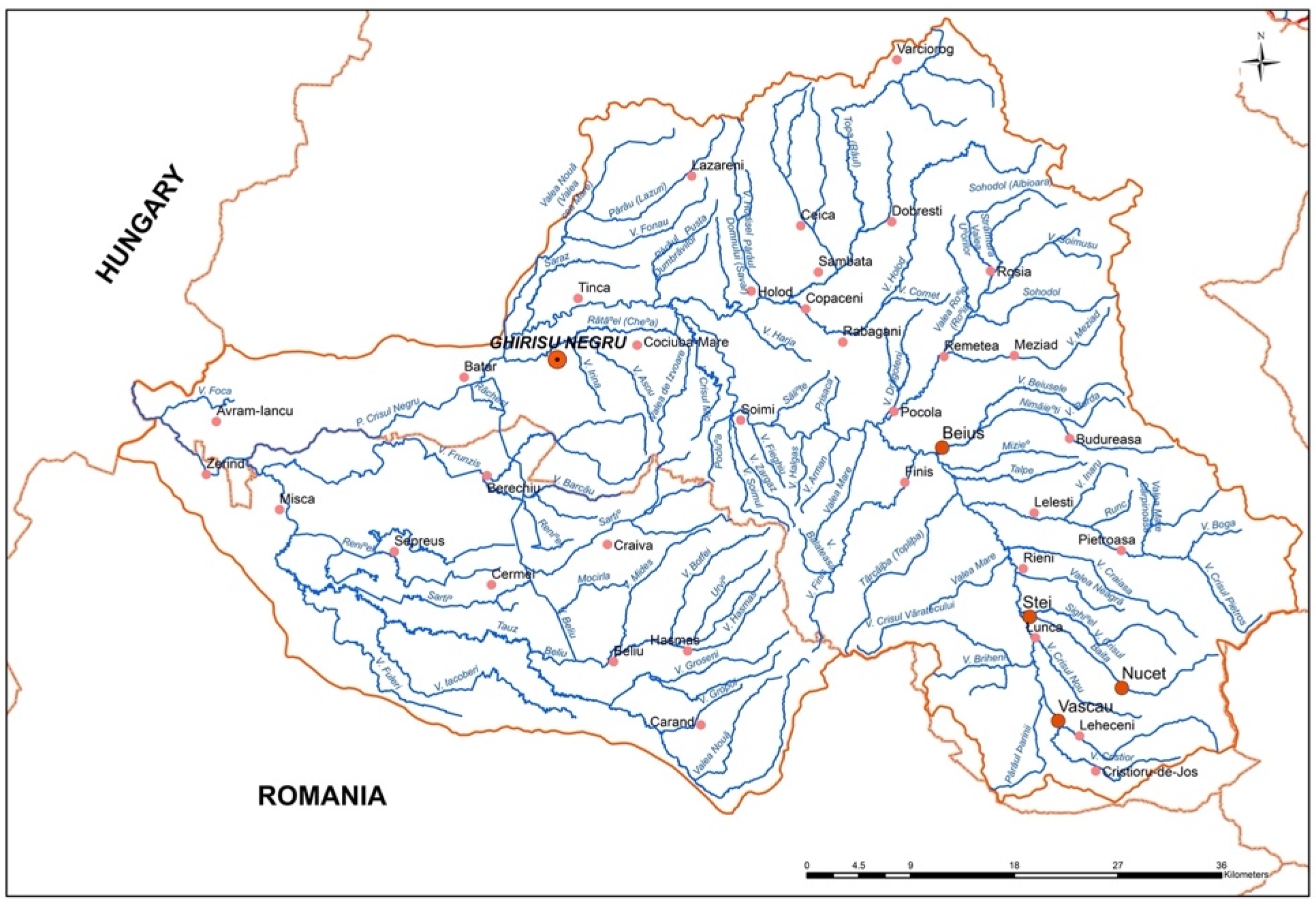
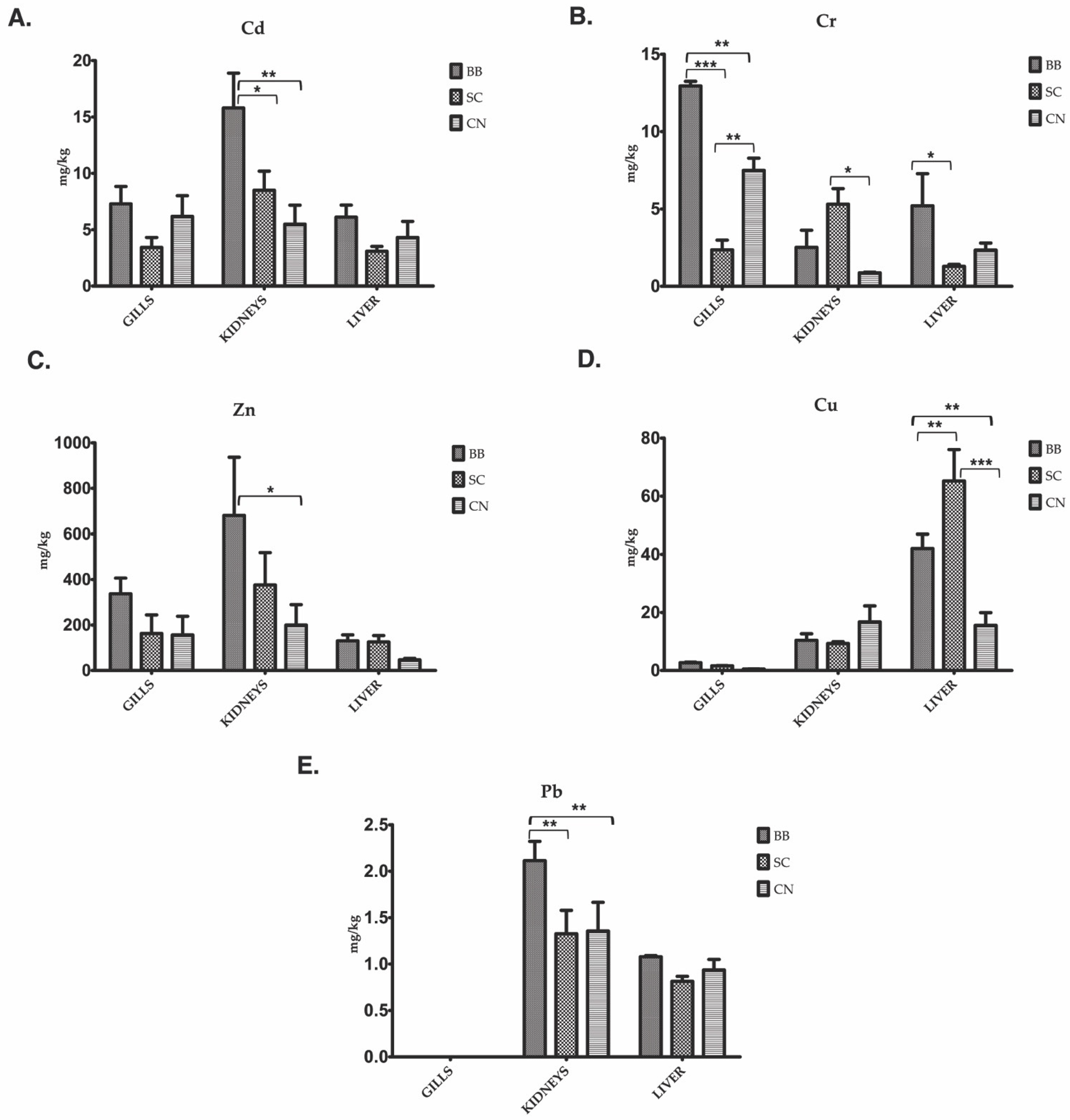
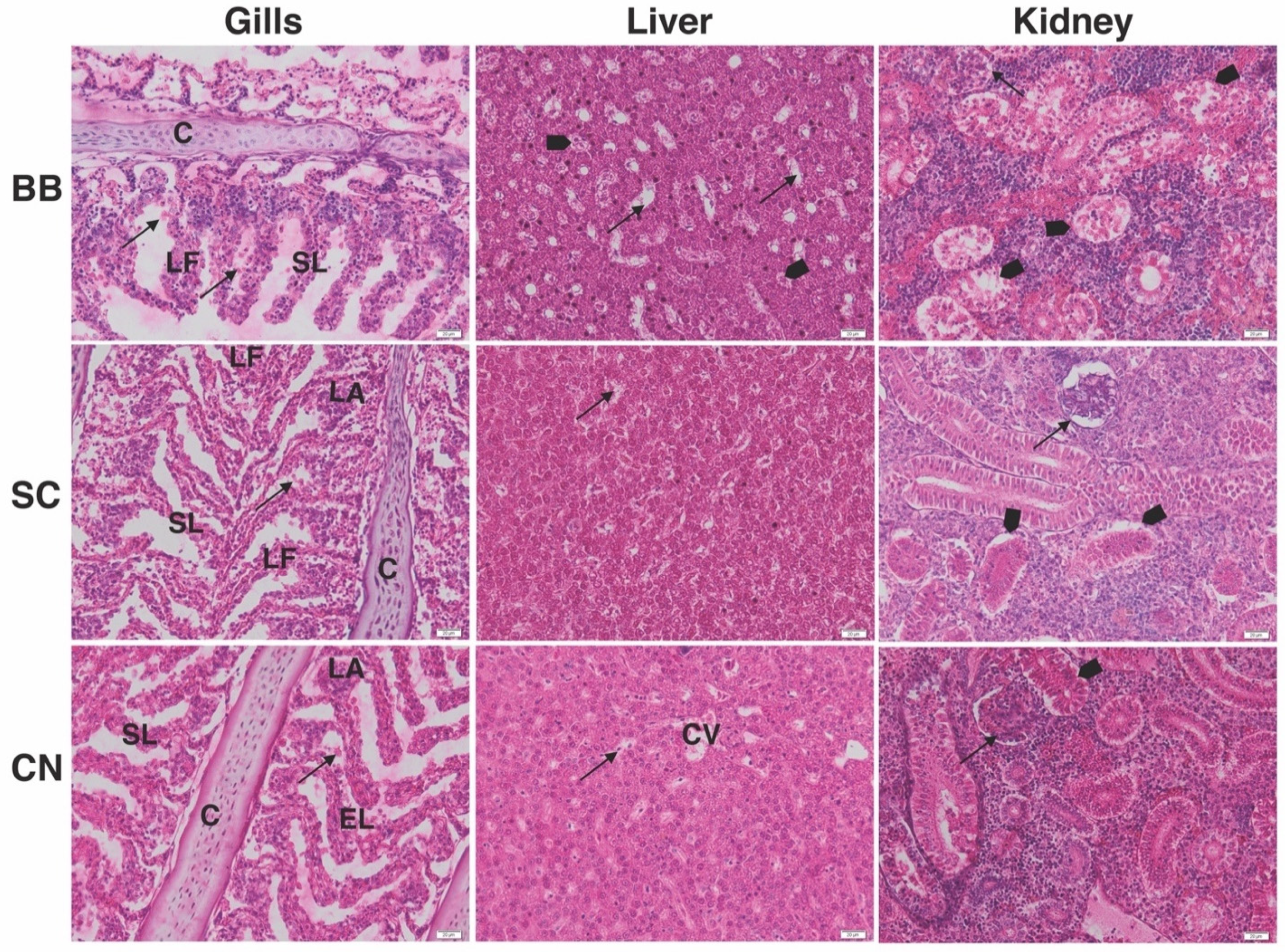
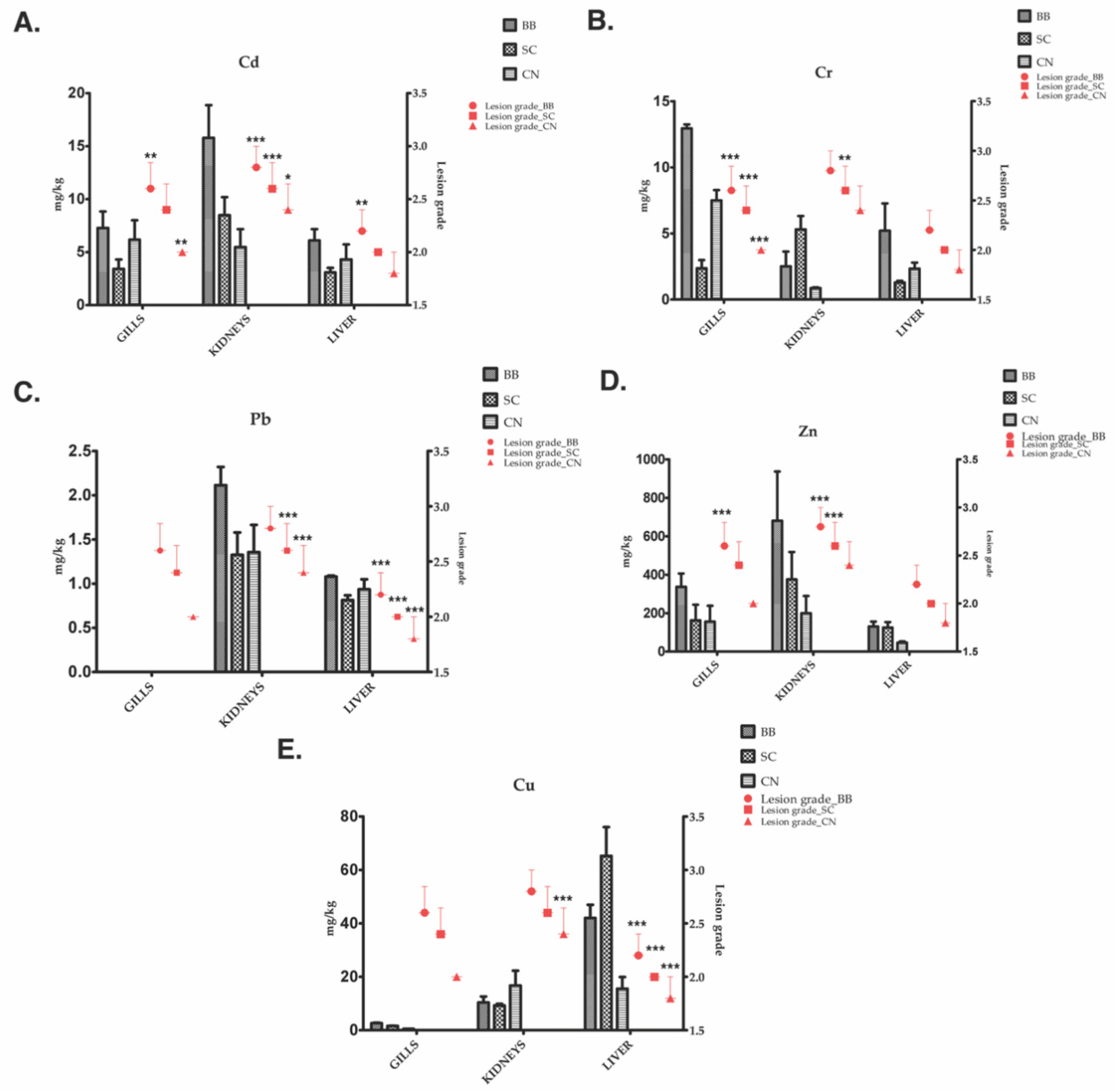
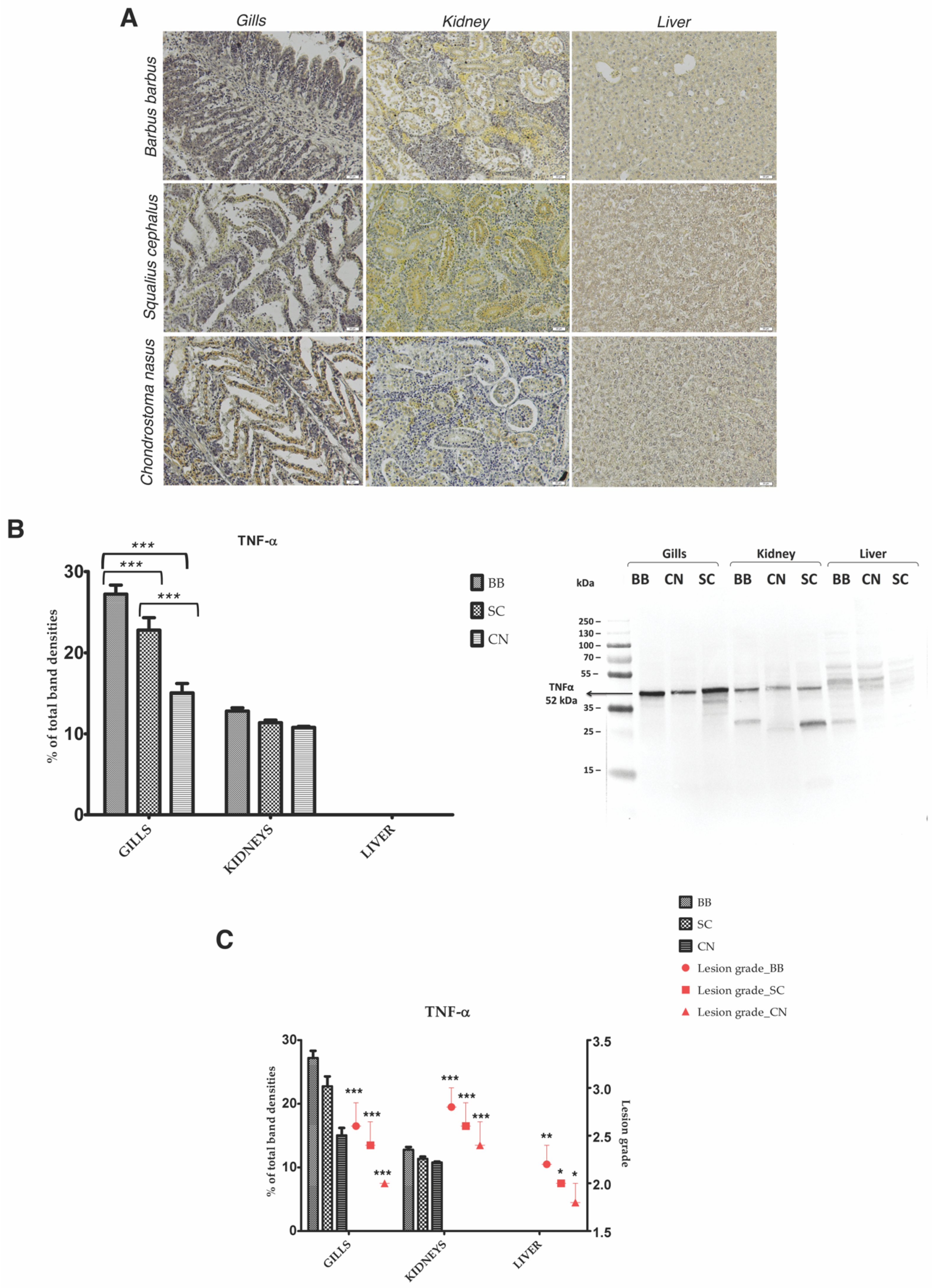
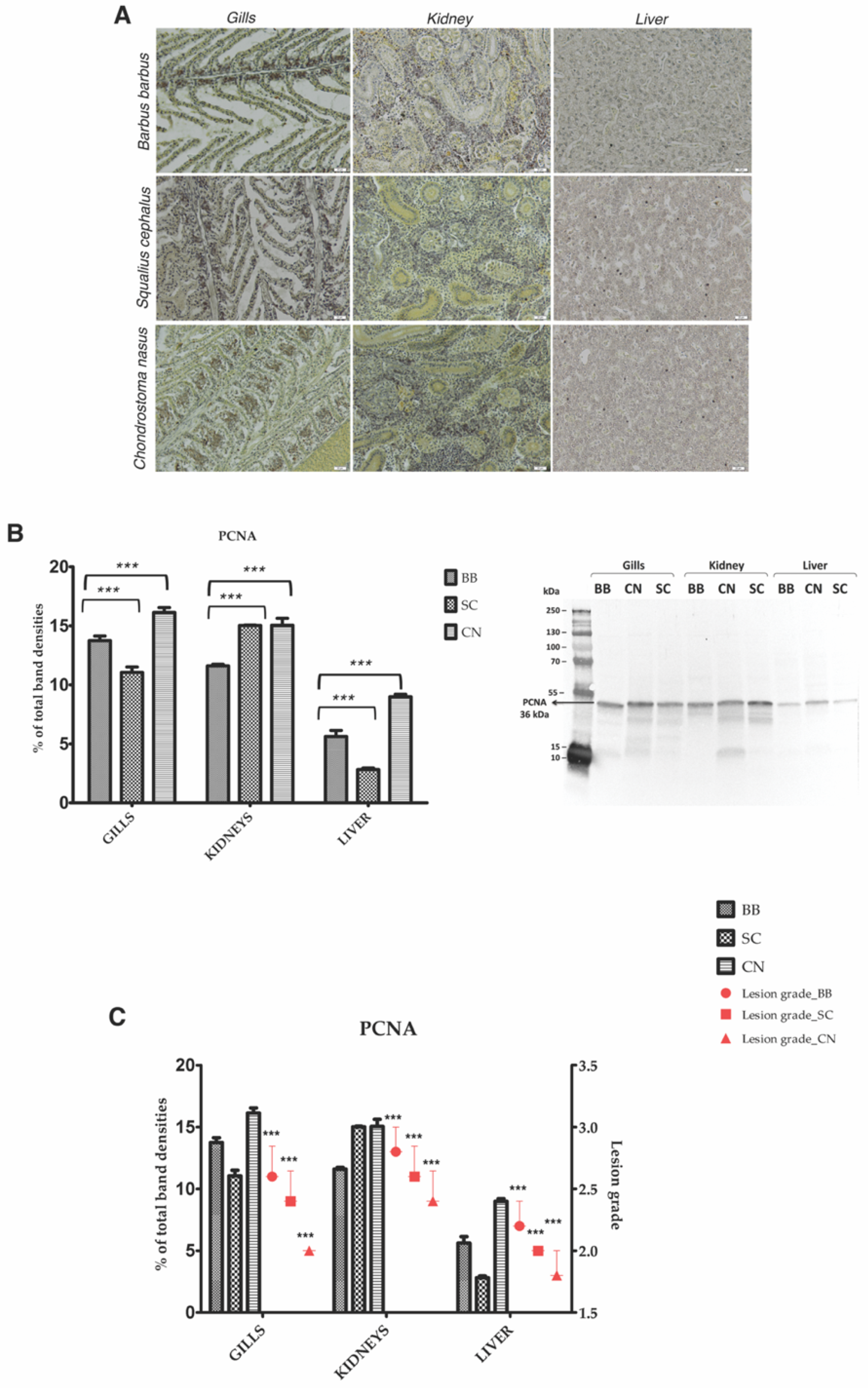
| Species | Family | Order | Main Feeding Habit |
|---|---|---|---|
| Barbus barbus | Cyprinidae | Cypriniformes | Mainly carnivorous (benthic organisms, including crustaceans, insect larvae and mollusks) |
| Chondrostoma nasus | Cyprinidae | Cypriniformes | Herbivorous (algae and other aquatic plants) |
| Squalius cephalus | Cyprinidae | Cypriniformes | Omnivorous (aquatic and terrestrial animal and plant material) |
| Tissue | Grade | Histopathological Changes |
|---|---|---|
| Gills | 1 | gill epithelium hyperplasia and hypertrophy, blood congestion, epithelial lifting of the lamellae, fusion or lamellar disorganization |
| 2 | incomplete fusion of the secondary lamellae, incomplete epithelium break, epithelial cell desquamation | |
| 3 | lamellar aneurysm, epithelial cells break with hemorrhage, complete fusion of all the lamellae, lamellar epithelium break | |
| Liver | 1 | normal aspect of hepatocytes, sinusoids slightly dilated |
| 2 | sinusoids slightly dilated and connective tissue expansion | |
| 3 | hypertrophic hepatocytes with vacuolated cytoplasm, dilated sinusoids | |
| Kidney | 1 | normal aspect of hematopoietic tissue, slightly dilated renal tubuli |
| 2 | mild dilated tubular epithelial cells and glomeruli/contraction | |
| 3 | hypertrophy or tubular/damaged renal tubuli, glomerular contraction, connective tissue expansion, decrease of the hematopoietic tissue |
| Heavy Metal | Water (mg/dm3) | Sediment (mg/kg Dry Weight) |
|---|---|---|
| Cd | <0.001 | 2.5; 2.5–2.5 |
| Cr | <0.01 | 35.95; 27.75–42.37 |
| Cu | <0.05 | 19.51; 17.91–21.53 |
| Pb | <0.003 | 30.40; 24.48–33.73 |
| Zn | <0.05 | 66.46; 61.10–69.50 |
Publisher’s Note: MDPI stays neutral with regard to jurisdictional claims in published maps and institutional affiliations. |
© 2021 by the authors. Licensee MDPI, Basel, Switzerland. This article is an open access article distributed under the terms and conditions of the Creative Commons Attribution (CC BY) license (https://creativecommons.org/licenses/by/4.0/).
Share and Cite
Onita, B.; Albu, P.; Herman, H.; Balta, C.; Lazar, V.; Fulop, A.; Baranyai, E.; Harangi, S.; Keki, S.; Nagy, L.; et al. Correlation between Heavy Metal-Induced Histopathological Changes and Trophic Interactions between Different Fish Species. Appl. Sci. 2021, 11, 3760. https://doi.org/10.3390/app11093760
Onita B, Albu P, Herman H, Balta C, Lazar V, Fulop A, Baranyai E, Harangi S, Keki S, Nagy L, et al. Correlation between Heavy Metal-Induced Histopathological Changes and Trophic Interactions between Different Fish Species. Applied Sciences. 2021; 11(9):3760. https://doi.org/10.3390/app11093760
Chicago/Turabian StyleOnita (Mladin), Bianca, Paul Albu, Hildegard Herman, Cornel Balta, Vasile Lazar, Andras Fulop, Edina Baranyai, Sándor Harangi, Sandor Keki, Lajos Nagy, and et al. 2021. "Correlation between Heavy Metal-Induced Histopathological Changes and Trophic Interactions between Different Fish Species" Applied Sciences 11, no. 9: 3760. https://doi.org/10.3390/app11093760
APA StyleOnita, B., Albu, P., Herman, H., Balta, C., Lazar, V., Fulop, A., Baranyai, E., Harangi, S., Keki, S., Nagy, L., Nagy, T., Józsa, V., Gál, D., Györe, K., Stan, M., Hermenean, A., & Dinischiotu, A. (2021). Correlation between Heavy Metal-Induced Histopathological Changes and Trophic Interactions between Different Fish Species. Applied Sciences, 11(9), 3760. https://doi.org/10.3390/app11093760












